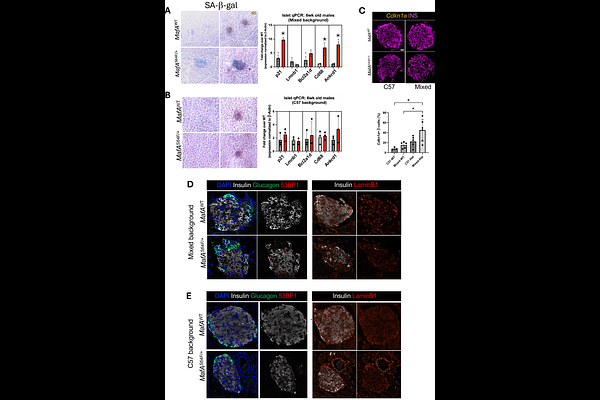Genetic background influences the heterogeneous phenotypes driven by the MAFAS64F MODY variant in male mice

Genetic background influences the heterogeneous phenotypes driven by the MAFAS64F MODY variant in male mice
Loyd, Z.; Lee, D.; Maurer, M.; Liu, J.-H.; Guo, M.; Reynolds, G.; Magnuson, M. A.; Cartailler, J.-P.; Stein, R.; Cha, J.
AbstractPancreatic {beta}-cells require several key factors to appropriately secrete insulin to maintain euglycemia. One such factor is MafA, a transcription factor fundamental to {beta}-cell function. We previously identified that a rare, naturally occurring mutation in MAFA (MAFAS64F) predisposes carriers to heterogenous conditions of either adult-onset diabetes or hypoglycemia. Curiously, MAFAS64F-associated diabetes is much more prevalent in men while women tend to present with hypoglycemia. A mouse model harboring this mutation (termed MafAS64F/+) mimicked the heterogeneous, sex-dependent phenotype: female MafAS64F/+ mice were hypoglycemic, while male MafAS64F/+ mice were hyperglycemic due to widespread, premature {beta}-cell aging and senescence. Here we show that genetic background modulates these heterogenous phenotypes: while male MafAS64F/+ mice on a mixed background of C57/Bl6J and SJL manifest overt diabetes by 5 weeks of age, MafAS64F/+ males on a C57/Bl6J background prevents this pathology. In contrast, female mice on both backgrounds (mixed and C57/Bl6J) similarly show hypoglycemia. We find that C57 MafAS64F/+ males show improved insulin secretion, abrogation of {beta}-cell senescence, and an islet MafA phosphorylation profile more similar to MafAWT males. Indeed, the abundance of MafAS64F in C57 MafAS64F/+ male islets was reduced compared to those from mixed background mice. Bulk RNAseq of isolated islets revealed differentially expressed genes (DEGs) including those encoding factors critical for insulin production, including Nkx6.2, Glis1, and Onecut1 and production of non-insulin islet hormones such as Cck, Gast, Gcg, and Sst. CUT&RUN mapping of MafA DNA binding sites in mouse {beta}-cells identified putative MafA- targets, and overlay of these CUT&RUN peaks with DEGs of each genetic background identified uniquely affected pathways, such as circadian regulation by MafAS64F in the mixed background. In sum, these data identified heterogeneity in glycemic phenotypes across genetic background as a result of differences in islet MafAS64F abundance and distinct pathways affected in MafAS64F/+ {beta}-cells at the intersection of cellular aging and circadian entrainment to modulate diabetes susceptibility.